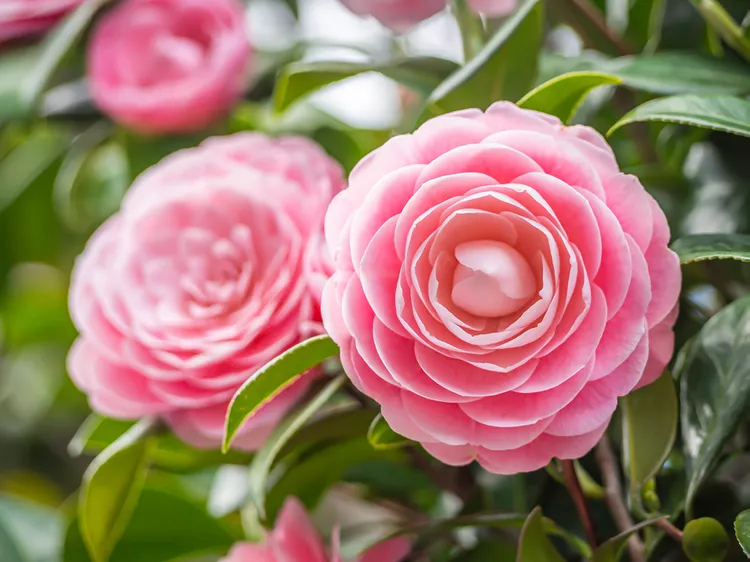In the South where I live, camellias are everywhere. If you've ever experienced these shrubs or small trees in full bloom, it's not hard to see why. Sometimes called the rose of winter or the queen of winter flowers, camellia varieties usually bloom during the colder months. In addition to looking like roses, camellia flowers can be shaped like anemones or peonies. The blooms can be single, double, and semi-double, and come in red, pink, white, or a mix of these colors. But there's much more to camellias than their beautiful flowers, such as these fascinating facts you probably don't know about them.
1. There are thousands of varieties of Camellias.
Native to Asia, there are more than 200 species of camellias and thousands of varieties. The most-popular types of camellias in America are japonicas, sasanquas, and reticulatas, says William Khoury, superintendent of gardens for the American Camellia Society and Massee Lane Gardens in Georgia. Some people create large collections of different types of camellias, favoring the big blooms to exhibit at flower shows.
2. They bloom in three seasons.
By choosing varieties with staggered bloom times, your camellia flower display can last for months between autumn and spring. For fall color, Khoury recommends growing sasanquas, which he describes as "sun-loving plants with small leaves and blooms." Some japonica cultivars will bloom from fall into spring, too. Khoury notes that reticulatas "have the largest blooms, tend to bloom in late winter and spring, and can be more sensitive to cold."
3. A summer-blooming camellia exists.
Khoury says breeders are working on new camellia hybrids that will bloom in the summer. Only one, "Wendzalea,' is currently available in the U.S. Its ruby-red, semi-double blooms open from July to November, and again from February through March. Camellias must be bred with a wild species from China, C. azalea (which is not a true azalea, Khoury points out) in order to bloom in summer or re-bloom. New cultivars also are being developed in trendy colors, he says, like yellow and purple.
4. Some varieties can grow in colder regions.
These evergreen shrubs and small trees aren't especially cold-hardy, so camellias have been limited mostly to USDA Zones 7-10. Breeders have created hardier varieties, though, and now there are several that can grow in Zone 6. One of the hardiest, Camellia japonica 'Korean Fire' may even survive with winter protection in Zone 5.
And if your climate is too cold for camellias, "pots are an option," says Jenny Rydebrink, founder and CEO of Gardenize, a mobile app for gardeners. Grow your camellias in large containers you can bring inside. Keep them in cool but not freezing temperatures, give them as much light as possible, and water them enough so the roots don't completely dry out. Move the pots back outside in spring when temperatures stay above freezing. Just don't move the pots around too much, Rydebrink warns, because this can cause flowers and buds to fall off.
5. Camellias are part of American history.
According to the American Camellia Society, the most popular camellia isn't usually grown in home gardens. It's Camellia sinensis; the species used to make tea. This commodity, you may remember, happened to be what got thrown overboard during the Boston Tea Party in protest of taxation without representation. This event was the first to rally colonists together to fight for independence from Great Britain, so you could say that camellias played an important role in starting the American Revolution.
6. Coco Chanel loved the flowers.
It's said that the camellia flower was a favorite for famed fashion designer Coco Chanel. Images of the elegant blooms showed up in her jewelry, handbags, clothes, and other products. She's also reported to have liked them because they weren't fragrant, so they didn't compete with her signature perfume, Chanel No. 5.
Best Camellias to Grow
If you'd like to try growing a few of these beautiful plants yourself, Khoury recommends looking for these newer and notable varieties.
- 'Strawberry Limeade' (C. sasanqua) for Zones 7-10. Strawberry-pink flowers have lime green tips and centers.
- 'Early Autumn' (C. japonica), Zones 7-10. Lavender-rose blooms open from early fall to late winter.
- Hybrid 'Dragon Fireball,' Zones 7-10. This camellia's anemone-shaped flowers are red with white margins, and open from late winter to mid-spring.
- 'Jim Smelley' (C. reticulata), Zones 8-10. Grow these bushes for their large, semi-double, dark-pink flowers with yellow antlers. They bloom from mid- to late-season.




















